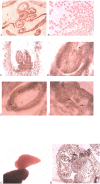Genetic diversity, reproductive capacity and alkaloids content in three endemic Alkanna species
- PMID: 32479498
- PMCID: PMC7263576
- DOI: 10.1371/journal.pone.0233516
Genetic diversity, reproductive capacity and alkaloids content in three endemic Alkanna species
Abstract
The Balkans endemic species Alkanna primuliflora Griseb., A. stribrnyi Velen., and A. graeca Boiss. & Spruner have limited distribution in the Balkan Peninsula and a large variation in the morphological characteristics. The populations of the three Alkanna species in the Bulgarian flora are small and fragmented. There are no previous reports on the chemical profile or on the embryology of these species. The hypothesis was that the limited distribution of A. primuliflora, A. stribrnyi, and A. graeca was due to their reproductive capacity and genetic diversity. Furthermore, we hypothesized that the three species will contain pyrrolizidine alkaloids (PAs), as other species of the genus Alkanna (Boraginaceae), but they would have differential alkaloids composition. The population genetic structure and differentiation showed a clear distinction between species and revealed average levels of genetic diversity among the natural populations of the three Alkanna species. The embryological investigation observed stability of the processes in the male and female generative spheres and high viability of mature pollen and embryo of the three species. The normal formation of male and female gametophytes without deviations or degenerative processes, and observed levels of genetic diversity between Alkanna individuals are important in maintaining the size and resilience of the Alkanna populations. Eight alkaloids were identified by GC-MS in A. primuliflora and A. graeca and six alkaloids in A. stribrnyi. The main pyrrolizidine alkaloids (PAs) in all investigated species was triangularine. A. primuliflora and A. graeca showed similar chemical composition that comprised 9-angeloylretronecine, 7-tigloylretronecine, 9-tigloylretronecine, triangularicine, dihydroxytriangularine, dihydroxytriangularicine, whereas, in A. stribrnyi 9-tigloylretronecine, triangularicine and dihydroxytriangularicine were not found. This is the first report on the presence of PAs in A. primuliflora, A. stribrnyi and A. graeca. Besides, this is the first report on the embryology of these endemic species. The results contribute to the knowledge of the three endemic Alkanna species and will facilitate policy-making and defining new strategies for their conservation.
Conflict of interest statement
NO authors have competing interests.
Figures




Similar articles
-
Analysis of alkannin derivatives from Alkanna species by high-performance liquid chromatography/photodiode array/mass spectrometry.Biomed Chromatogr. 2006 Dec;20(12):1359-74. doi: 10.1002/bmc.705. Biomed Chromatogr. 2006. PMID: 17080496
-
Quantitative determination of alkannins and shikonins in endemic Mediterranean Alkanna species.Biomed Chromatogr. 2014 Jul;28(7):923-33. doi: 10.1002/bmc.3096. Epub 2013 Dec 11. Biomed Chromatogr. 2014. PMID: 24327564
-
The chemical profile of pyrrolizidine alkaloids from selected greek endemic boraginaceae plants determined by gas chromatography/mass spectrometry.J AOAC Int. 2014 Sep-Oct;97(5):1244-9. doi: 10.5740/jaoacint.SGEDamianakos. J AOAC Int. 2014. PMID: 25902972
-
The Activity of Alkanna Species in vitro Culture and Intact Plant Extracts Against Antibiotic Resistant Bacteria.Curr Pharm Des. 2019;25(16):1861-1865. doi: 10.2174/1381612825666190716112510. Curr Pharm Des. 2019. PMID: 31333091 Review.
-
Pyrrolizidine alkaloids in plants used in the traditional medicine of Madagascar and the Mascarene islands.Pharmazie. 2011 Sep;66(9):637-47. Pharmazie. 2011. PMID: 22026117 Review.
Cited by
-
Spatial and Ecological Drivers of Genetic Structure in Greek Populations of Alkanna tinctoria (Boraginaceae), a Polyploid Medicinal Herb.Front Plant Sci. 2021 Jul 14;12:706574. doi: 10.3389/fpls.2021.706574. eCollection 2021. Front Plant Sci. 2021. PMID: 34335669 Free PMC article.
-
Pyrrolizidine Alkaloids-Pros and Cons for Pharmaceutical and Medical Applications.Int J Mol Sci. 2023 Nov 30;24(23):16972. doi: 10.3390/ijms242316972. Int J Mol Sci. 2023. PMID: 38069294 Free PMC article. Review.
-
Metabolic Profiles, Genetic Diversity, and Genome Size of Bulgarian Population of Alkanna tinctoria.Plants (Basel). 2022 Dec 26;12(1):111. doi: 10.3390/plants12010111. Plants (Basel). 2022. PMID: 36616241 Free PMC article.
References
-
- Heywood VH. Flowering Plants of the World RFLP markers. Oxford University Press, Oxford;. 1978.
-
- Riedl H. Boraginaceae In: Rechinger KH. (ed.) Flora Iranica 48. Akademische Druck- und Verlagsanstalt, Graz: 1978; pp. 1–281.
-
- Strid A. Alkanna Tausch In: Strid A. and Tan K. (ed.), Mountain flora of Greece, 2. Edinburgh: 1991; pp. 39–41.
-
- Kožuharov S. Alkanna Tausch In: Tutin TG, Heywood VH, Burges NA, Moore DM, Valentine DH, Walters SM, Webb DA. (eds.): Flora Europaea, 3. Cambridge: 1972; pp. 95–97.
-
- Akçin ÖE, Kandemir N, Cansaran A. A Morphological and Anatomical Study on Endemic Alkanna haussknechtii Bornm. (Boraginaceae), Critically Endangered in Turkey. Turk J Bot. 2004; 28: 591–598. Available from: https://www.semanticscholar.org/paper/A-Morphological-and-Anatomical-Stu...
Publication types
MeSH terms
Substances
LinkOut - more resources
Full Text Sources
Miscellaneous

